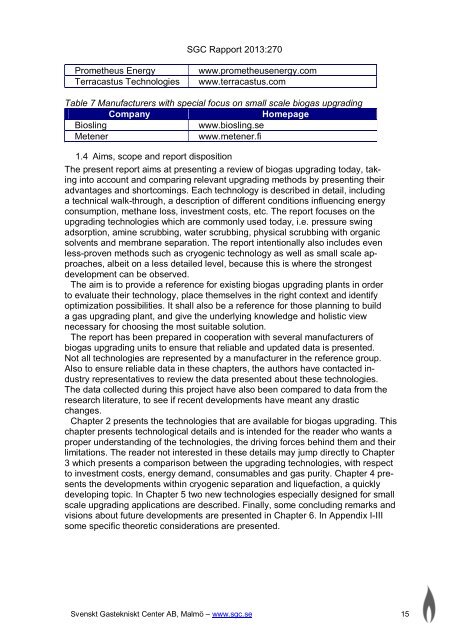Biogas upgrading – Review of commercial technologies - SGC
Biogas upgrading – Review of commercial technologies - SGC
Biogas upgrading – Review of commercial technologies - SGC
You also want an ePaper? Increase the reach of your titles
YUMPU automatically turns print PDFs into web optimized ePapers that Google loves.
<strong>SGC</strong> Rapport 2013:270<br />
Prometheus Energy www.prometheusenergy.com<br />
Terracastus Technologies www.terracastus.com<br />
Table 7 Manufacturers with special focus on small scale biogas <strong>upgrading</strong><br />
Company Homepage<br />
Biosling www.biosling.se<br />
Metener www.metener.fi<br />
1.4 Aims, scope and report disposition<br />
The present report aims at presenting a review <strong>of</strong> biogas <strong>upgrading</strong> today, taking<br />
into account and comparing relevant <strong>upgrading</strong> methods by presenting their<br />
advantages and shortcomings. Each technology is described in detail, including<br />
a technical walk-through, a description <strong>of</strong> different conditions influencing energy<br />
consumption, methane loss, investment costs, etc. The report focuses on the<br />
<strong>upgrading</strong> <strong>technologies</strong> which are commonly used today, i.e. pressure swing<br />
adsorption, amine scrubbing, water scrubbing, physical scrubbing with organic<br />
solvents and membrane separation. The report intentionally also includes even<br />
less-proven methods such as cryogenic technology as well as small scale approaches,<br />
albeit on a less detailed level, because this is where the strongest<br />
development can be observed.<br />
The aim is to provide a reference for existing biogas <strong>upgrading</strong> plants in order<br />
to evaluate their technology, place themselves in the right context and identify<br />
optimization possibilities. It shall also be a reference for those planning to build<br />
a gas <strong>upgrading</strong> plant, and give the underlying knowledge and holistic view<br />
necessary for choosing the most suitable solution.<br />
The report has been prepared in cooperation with several manufacturers <strong>of</strong><br />
biogas <strong>upgrading</strong> units to ensure that reliable and updated data is presented.<br />
Not all <strong>technologies</strong> are represented by a manufacturer in the reference group.<br />
Also to ensure reliable data in these chapters, the authors have contacted industry<br />
representatives to review the data presented about these <strong>technologies</strong>.<br />
The data collected during this project have also been compared to data from the<br />
research literature, to see if recent developments have meant any drastic<br />
changes.<br />
Chapter 2 presents the <strong>technologies</strong> that are available for biogas <strong>upgrading</strong>. This<br />
chapter presents technological details and is intended for the reader who wants a<br />
proper understanding <strong>of</strong> the <strong>technologies</strong>, the driving forces behind them and their<br />
limitations. The reader not interested in these details may jump directly to Chapter<br />
3 which presents a comparison between the <strong>upgrading</strong> <strong>technologies</strong>, with respect<br />
to investment costs, energy demand, consumables and gas purity. Chapter 4 presents<br />
the developments within cryogenic separation and liquefaction, a quickly<br />
developing topic. In Chapter 5 two new <strong>technologies</strong> especially designed for small<br />
scale <strong>upgrading</strong> applications are described. Finally, some concluding remarks and<br />
visions about future developments are presented in Chapter 6. In Appendix I-III<br />
some specific theoretic considerations are presented.<br />
Svenskt Gastekniskt Center AB, Malmö <strong>–</strong> www.sgc.se 15

















